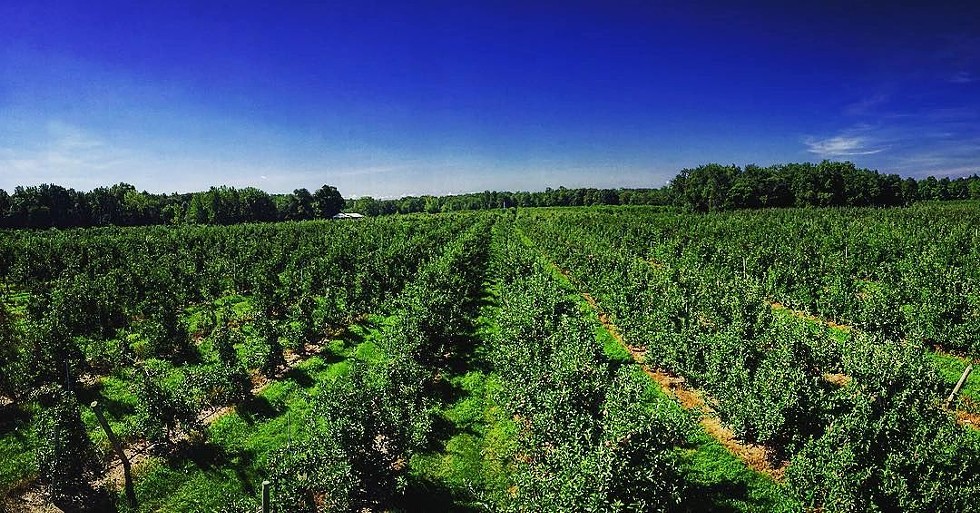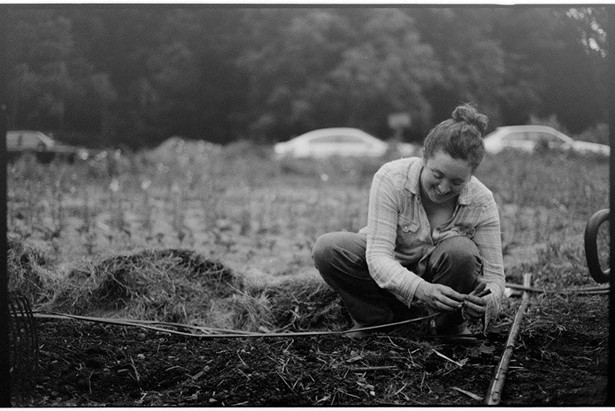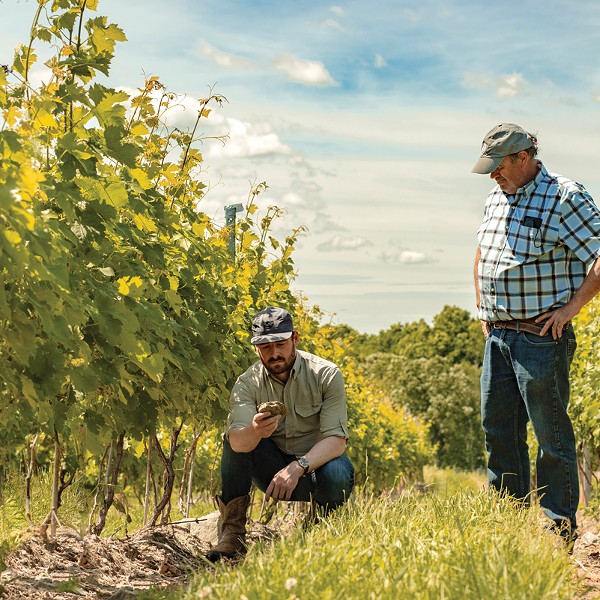Christmas Eve of 2020 brought a storm to the Hudson Valley that one might describe as tropical. Temperatures reached upwards of 60° Fahrenheit, wind speeds hit 60 miles per hour, and parts of the region received over two inches of rain. This followed, by about eight days, a winter storm that in a matter of hours deposited up to two feet of snow. By Christmas morning, nearly all of it was gone.
A couple decades ago, a December weather sequence like this would have been anomalous. But such is winter now in the Hudson Valley. In some respects, this bizarre weather was an appropriate capstone to a strange and dismal year.
Though we might like to turn the page on 2020, left unsaid in our desire to return to normal is that COVID is one of many interlocking crises currently afflicting the globe; just because the coronavirus has dominated the headlines for the last year does not mean the others have abated. The climate crisis is certainly the biggest of these emergencies. Indeed, COVID itself is an expression of ecological disturbance on an increasingly disharmonious planet, and two-thirds of emerging diseases today are pathogens that jump from nonhuman animals to humans.
The effects of climate change in the Hudson Valley are easy to list: rising temperatures; more frequent and more intense precipitation; increases in infectious disease vectors like mosquitoes and ticks; increasing spread of plant diseases; flooding along the Hudson River due to sea level rise; prolonged periods of drought. All of these phenomena presently occur in striking ways, even as many of us get used to them.
But how does climate change feel? What is the experience of the food growers of the Hudson Valley—an absolutely vital component of the viability, even survival, of this region? With these questions in mind, I spoke to several local farmers about their views on this broad subject.
Rising Temperatures & Shifting Seasons
Dramatic temperature swings are increasingly common in a warming Hudson Valley. This variability, particularly in the context of irregular seasonal transitions, is especially burdensome for fruit growers. “The biggest thing we’ve noticed [are] the fluctuations in the weather between falls and springs,” says Brad Clarke, owner of Clarke’s Family Farm in Modena, which grows apples, pears, peaches, and other crops using a mix of organic and Integrated Pest Management techniques.
Holly Brittain, co-owner of Rose Hill Farm in Red Hook, also grows a variety of apples and stone fruit, and describes this exact problem. “If it gets unnaturally warm in February, and then the temperature dips again, the fruit could be budding too early, and then all the flowers drop off, and you could lose your entire crop.” This is, in fact, exactly what happened to Clarke five or six years ago; he tells me that their farm lost an entire peach crop, which he notes was a first in his father’s lifetime (Clarke’s father is 76, and has been farming in Modena his entire life).

The issue of unseasonably early blooming is also familiar to Marybeth Wehrung, who grows a wide variety of flowers using no-till methods at Stars of the Meadow Farm in Accord. (Disclaimer: I have occasionally worked for Wehrung.) She describes the disruption of typical perennial cycles she experienced after last year’s mild winter.
“Things came out of dormancy on and off…February/March especially were too warm, and so a lot of [perennials] emerged sooner than [they] may have and [then] got some damage from frost,” Wehrung says. She mentions losing an entire perennial crop—Dutch iris—she had planted the previous fall, after buds formed too early and succumbed to subsequent frost. Her dahlias met a similar fate in the fall; in that case, they were devastated by an early frost.
More Precipitation, More Drought
Shifting precipitation patterns in the Hudson Valley—specifically, the increase in heavy precipitation events, often interspersed with extended periods of drought—are another major challenge for local farmers. While extreme precipitation is a frequently cited characteristic of climate change, last year annual rainfall in much of the Hudson Valley was actually below average.
That aridity creates challenges for keeping vegetables hydrated, especially in areas with fast-draining, sandy soils. For this and other reasons, many farmers use thin, single-use, plastic “mulch” to retain moisture and suppress weeds. At Deep Roots Farm in Copake last year, “everything that was on black plastic was so lush,” says farmer Scott O’Rourke. O’Rourke would prefer to completely avoid the material, but he considers it a necessity in his sandy soil: five acres of his crops that were not planted under plastic burned in the summer’s extreme heat.
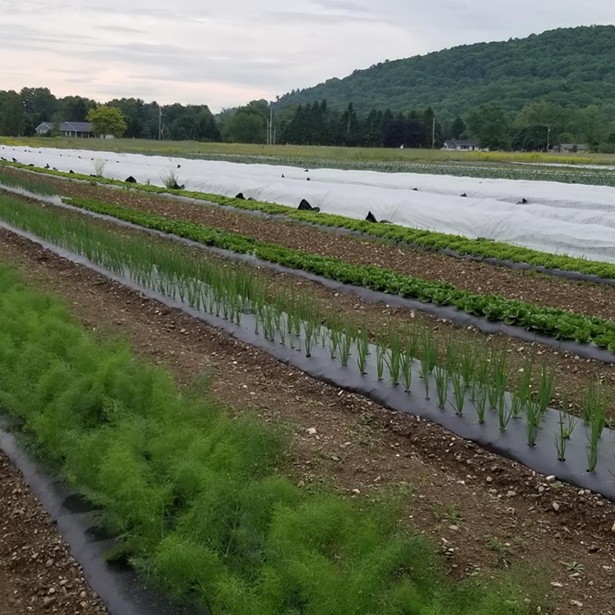
When precipitation does come, it increasingly falls in downpours. This can lead to all sorts of issues: flooding, erosion, and over-saturated soil unable to absorb that much water. Sam Zurofsky, co-owner of Long Season Farm in Kerhonkson, grows vegetables year-round, and notes how planning has shifted to accommodate the likelihood of these events: “There are things we have to manage for actively, that maybe 20 years ago…were just less likely, or less frequent.” He says that his farm plans to install surface drainage outside one tunnel that is particularly prone to flooding.
Heavy, wet snowfalls are another worrisome phenomenon. Tyler Huff, of three-year-old Mossy Stone Farms, was the only farmer I spoke to not strictly in the Hudson Valley. He and his wife grow a variety of fruit, vegetables, mushrooms, and even rice on their small property in Prattsville in the northern Catskills, at an elevation of about 2,000 feet, utilizing (like Wehrung) no-till and wholly non-mechanized methods. Huff notes the impact of severe winter precipitation on his property. “We got a snow about two weeks ago,” he says, referencing the snowstorm a week before Christmas, “and it dumped about 22 inches of snow in two hours, and collapsed my greenhouse.”
Increasing Pest Pressure
Pest pressure amplified by climate change presents yet another challenge for farmers. High in the mountains, Mossy Stone Farms arguably has a level of protection from this and other issues that farmers down-valley lack. But Huff deals with an increasingly heavy pest presence. “The first year I was up here there was really little pest pressure at all,” he says. “This year I had Colorado potato beetles like crazy. I had aphid problems for the first time. You don’t [typically] have aphid problems at 2,000 feet because of the winters.” He also dealt with squash bugs, cucumber beetles, and cabbage loopers.
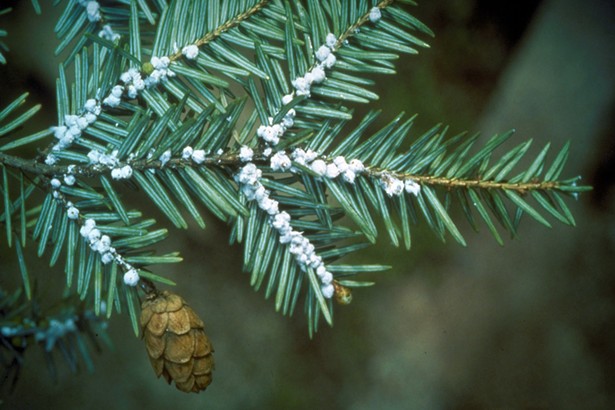
Huff observes the pest and disease pressure on the Catskill forests surrounding his farm, specifically noting the ash trees. “We didn’t have ash borer problems until last year up here,” he explains. He also mentions the wooly adelgid now afflicting the hemlocks, and the spread of Dutch elm disease over the past decade and a half. “It’s a different ecosystem that’s come up the mountain, and now [we’re] really starting to have the same problems ecosystems [down-valley]…have been having for 15-20 years,” he says.
Overlapping Problems
Through these conversations, the intersecting variability of climate change stands out above all. Effects of “climate chaos,” as Wehrung calls it, reinforce each other. She describes how a warm winter followed by a cool spring followed by a dry summer creates compounding challenges. “Low rainfall all season made for less productive [plants], fewer stems,” she says. “[The] accumulation of all the different stresses, with the frost, things getting set back all the time, having intense heat sometimes and then no rainfall—the overall stress level on plants was high, and so pest pressure and other kinds of damage were higher.”
Indeed, as much as we can observe broader trends—warmer winters, heavier precipitation events, longer dry spells—these general contours don’t necessarily translate into a neat shift. “A lot of people assume that with a warming climate, that means we’ll be able to grow things that grow in warmer climates, and that’s not really true,” says Jay Armour, of Four Winds Farm, a primarily vegetable operation in Gardiner. Armour notes that this region’s frost-free dates have not really changed. “This year we had frost on the 12th or 13th of May, and our frost-free date is the 15th…If you tried to plant things that are going to get hit by the frost early, you would’ve been out of luck.”
The observation highlights an essential nuance of climate change: simply observing that average yearly temperatures in the Hudson Valley are rising may obscure the irregularity contained within that shift. The Hudson Valley does not so much have a new, warmer climate as a variable and disturbed version of an older climate. A theoretical extended growing season due to climate change will regularly be offset by long and lingering heat waves, early or late frosts, novel or more severe diseases. Climate change is not proceeding in a steady or stable—and therefore predictable—manner. Instead, it reveals ecology in severe imbalance.
Mitigation
All the farmers I spoke with described ways they work to mitigate the impacts of climate change. Brittain describes how Rose Hill employs practices like longer-term crop rotation, cover cropping prior to new cultivation, and using interplantings like white clover, alfalfa, white yarrow, coriander, and dill within orchard rows to help hold water. O’Rourke echoes the utility of cover cropping: “It breaks down so fast, even if you don’t till it up very much, and it adds a lot to the moisture retention of the soil.”
Water retention is a subject that comes up frequently: healthier soil that is high in organic matter and can better hold water is an obvious boon in drought times and a significant asset in high-precipitation events. This process of building and maintaining healthy soil suggests a recurring truism for farmers: the best defense against the unpredictability of a shifting climate may be regenerative, holistic practices. Armour takes this approach, and has practiced no-till farming for over 25 years. While he initially stopped rototilling to ease the burden of constant weeding, he has seen the benefits of that approach in terms of soil health. “I think that more farms need to be moving in this direction of not tilling, of improving soil organic matter, so that the soils will better manage extreme rainfall events,” he says. No-till methods also help retain carbon in the soil.
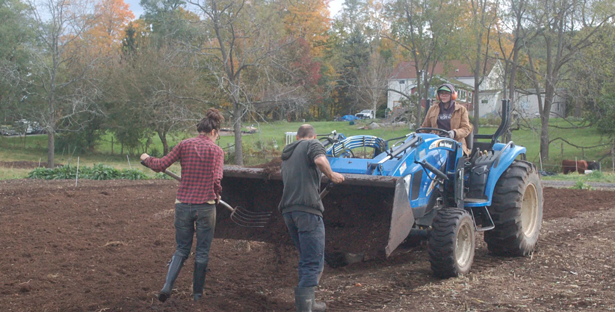
Zurofsky stresses that the complexity of climate change and its causes necessitates that farmers and non-farmers consider best practices and tradeoffs in a more nuanced way. He points out, for instance, that no-till conventional agriculture may be less harmful to the environment—at least in terms of releasing carbon—than tillage-based organic agriculture. “We become balkanized or siloed in our thinking where we have this [approach that says], ‘I’m opposed to carbon, therefore anything that’s not burning fossil fuels is good,’ or, ‘I’m in favor of organic agriculture, therefore anything that has to do with new technology is bad.’” He expresses a personal openness to new technologies, like CRISPR gene editing, that may not presently conform to strict ideas of “organic,” but that, in his view, ought to be meaningfully explored by the organic farming community.
The Big Picture
Along with Wehrung, Huff stresses that the present reality of climate change is rooted in a particularly Western historical pattern of anthropogenic destruction. He talks about the denuding of the original old-growth forests covering the Catskills and the consequent runoff of their topsoil to the ocean, the ecological trauma of this centuries-old legacy visibly reflected in the landscape where he lives.
The threats to remote areas of the region, like Huff’s, help throw the reality of climate change into particularly stark relief. It remains unclear how these changes will continue and accelerate into the future. And of course, this local portrait does not take into account other attendant effects of climate change—effects that, as with COVID, are inevitably globally intersecting in the 21st century. Drought in California, for instance, or extreme flooding in the Great Plains, will affect food systems in the Hudson Valley. So will non-specifically agricultural events, like severe storms along the East Coast and widespread biodiversity collapse.
The interconnecting complexity underscores the urgency of holistic, regenerative practices that mitigate the worst effects of climate breakdown. Immediate measures include: promoting resilience in the region by building healthy soil; thinking beyond “organic” and other certifications toward holistic and adaptive agricultural methods; and expanding and strengthening local food systems, with a focus on promoting radical equity in these systems. Education is also vital; despite the widespread acceptance of climate change as a defining existential issue, its urgency and catastrophic import often remain misunderstood, or minimized.
Perhaps above all, we ought to think about place—the local ecology, wherever we are, and the best ways to develop healthy long-term relationships with it. As Wehrung points out, connection to ecology in a rapidly and frighteningly changing landscape is vital. “There’s a way we have to not cut off from loving what’s around us, and that’s what happens for me when I get scared,” she says. “I get skeptical and freaked out by it raining, or not snowing, and that keeps me from realizing how much I care, and what it’s possible we can do.
“We’ve got to remember how much impact we can still have, and how much we are having.”







